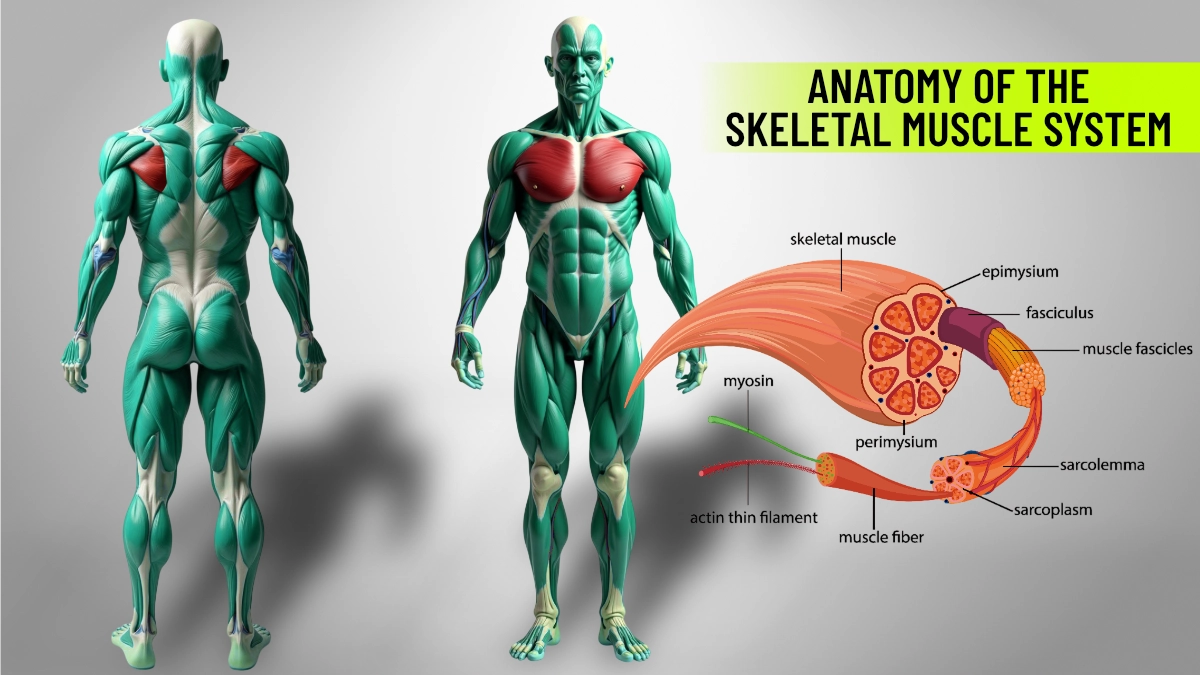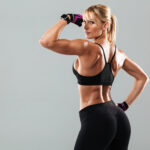Explore the fundamentals of resistance training with this in-depth guide to the body’s major muscle groups — how they function, why they matter, and the best exercises to target each one effectively.
Myology (from latin myos \”muscle\” and logia, \”logy\”) is the science that studies muscles, their physical structure, type of fibers, specific function, and the connections between different muscle groups.
National Library of Medicine
Introduction to the Human Musculature System: Muscles, Functions & Fitness Relevance
Unlocking the secrets of your body’s musculature is the key to transforming your fitness journey, whether you’re a beginner hitting the gym in Dubai’s Jumeirah Beach Residence or an athlete training for peak performance. Understanding which muscles power your movements allows you to train smarter, prevent injuries, and sculpt a balanced, powerful physique. As a Dubai-based personal trainer with a degree in Sports Science from Loughborough University and 14 years of experience (certified by the NSCA and ACSM), I’ve helped clients from all walks of life—from expats in Dubai Marina to locals in Mirdif—achieve their goals despite the city’s scorching climate.
This guide dives deep into the 11 major muscle groups, their functions, and the best exercises to train them, backed by cutting-edge research. Plus, I’ll share proven strategies for strength training in Dubai’s summer heat, ensuring you stay safe and effective.
How Understanding Muscle Anatomy Boosts Strength Training Results
A solid grasp of muscle anatomy is your blueprint for safe, effective workouts. Research from the Journal of Strength and Conditioning Research shows that balanced training across muscle groups reduces injury risk by up to 40% and enhances performance [1]. Overemphasizing “mirror muscles” like the chest or abs while neglecting the glutes or back can lead to poor posture, shoulder impingement, or knee injuries.
In Dubai, where temperatures can hit 50.1°C (122°F) in July [2], understanding how to train efficiently is critical to avoid heat-related setbacks. This guide combines science-backed insights with practical tips, tailored for Dubai’s unique fitness culture and climate.
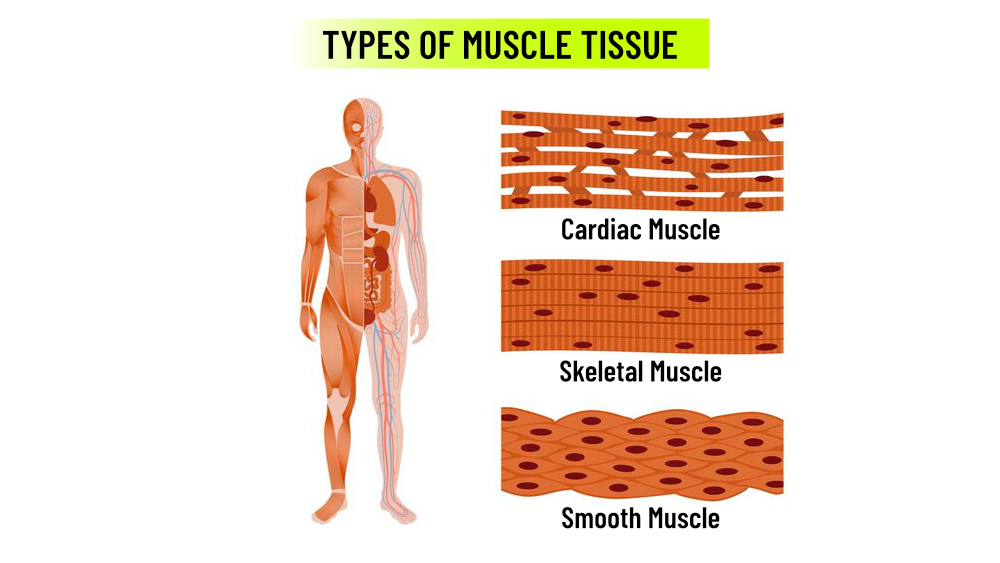
Key Benefits of Muscle Knowledge:
- Prevents imbalances for better posture and function.
- Enhances athletic performance and aesthetics.
- Reduces injury risk, especially in hot climates where fatigue sets in faster.
Knowing muscle anatomy helps you train smarter, prevent injuries, improve posture, and enhance performance—especially in Dubai’s intense heat.
Major Muscle Groups: Structure, Function, and Training
Below is a comprehensive breakdown of the 11 major muscle groups, each with a detailed structure, function, top exercises, and Dubai-specific training tips. I’ve included quick-reference summaries and insights from my experience training clients in Dubai’s gyms, from boutique studios in DIFC to CrossFit hubs in Al Quoz.
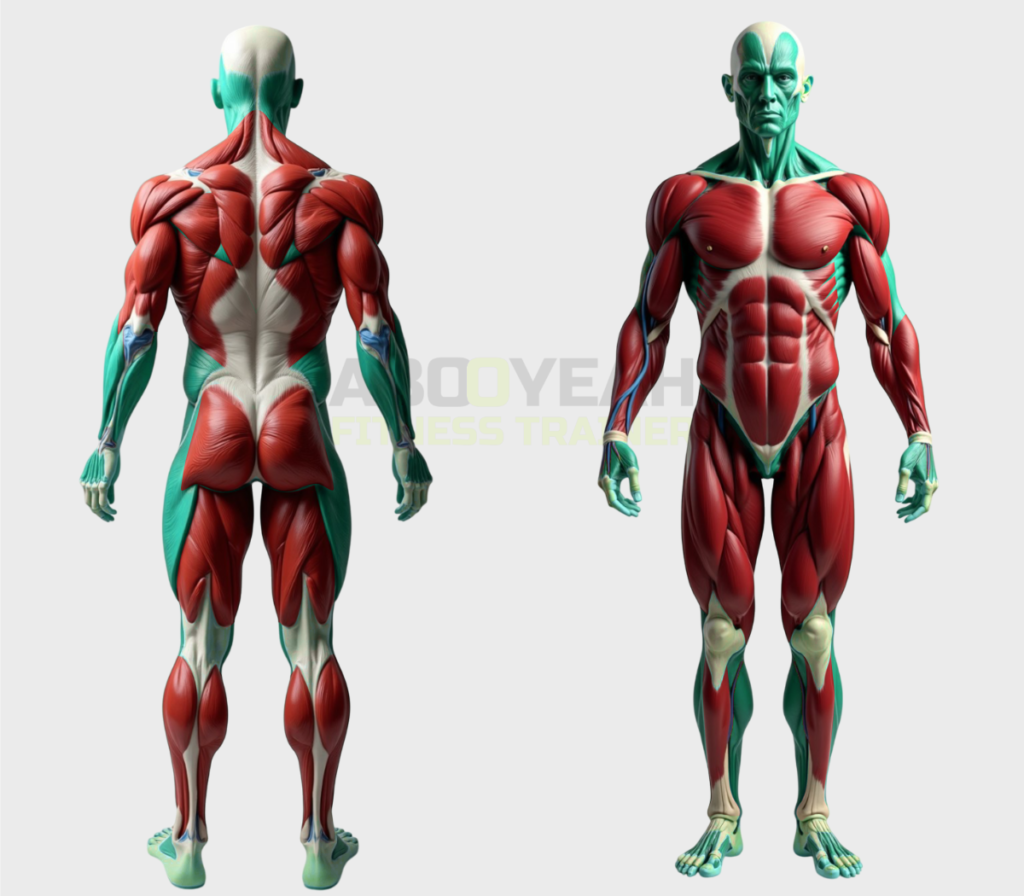
Take the First Step Toward Your Best Body.
Glutes
The gluteal muscles: gluteus maximus (largest, forming the buttocks), gluteus medius, and gluteus minimus—originate from the pelvis and insert into the femur, providing power and stability. These muscles are pivotal for providing power and stability, essential for movements like hip extension, abduction, and rotation. Their role extends beyond aesthetics, particularly for men who may historically prioritize upper body training, such as chest and biceps, over lower body strength.

Function
Responsible for hip extension (e.g., standing, sprinting), abduction (leg moving outward), and rotation. A 2019 study in Medical News Today links weak glutes to lower back pain, emphasizing their role in spinal stability [3].
Best Exercises
- Barbell Hip Thrusts: Sit with upper back on a bench, barbell across hips, thrust upward (targets gluteus maximus).
- Weighted Glute Bridges: Lie on back, knees bent, lift hips to align with shoulders (activation-focused).
- Romanian Deadlift (RDL): Hinge at hips with dumbbells, keeping legs straighter (glutes and hamstrings).
- Goblet Squats: Hold a dumbbell at chest, squat deeply (full lower body engagement).
- Dumbbell Straight-Leg Deadlift: Focuses on glutes and hamstrings.
- Barbell Back Squat: Engages glutes along with quads for lower-body strength.
- Front Dumbbell Lunge: Targets glutes, quads, and hamstrings for leg strength and balance.
- Barbell Deadlift: Works glutes as part of total-body strength.
- Dumbbell Squat: Engages glutes and quads.
Scientific Evidence: Why Men Should also Prioritize Glute Training
Scientific studies consistently reinforce why prioritizing glute training is crucial for men. Strong gluteal muscles not only power hip extension and stabilize the pelvis, thereby offloading stress from the lumbar spine and reducing chronic lower back pain, but also maintain proper femur alignment during closed‑chain movements, preventing excessive medial rotation and common knee issues like patellar tracking dysfunction.
Moreover, research shows that targeted, high‑volume glute work enhances explosive strength, endurance, and overall athletic performance in activities from sprinting to heavy lifts. In short, building robust glutes supports spinal health, protects knee joints, and unleashes the power and efficiency needed for both sport and daily life.
Gluteal strength is crucial for reducing low back pain and improving athletic performance.
Distefano L. J., et al. (2009)
From my experience as a Dubai-based personal trainer with 14 years in the field, I’ve witnessed the powerful impact of glute-focused training. One client, Anas a busy professional who struggled with persistent lower back pain, especially after long hours at his desk.
By incorporating targeted movements like non-weighted hip thrusts and hip abductor exercises into his routine, we significantly improved his glute activation. Within weeks, his posture improved, his back pain eased, and he found greater comfort during his workday. Glute training doesn’t just shape the body it restores function and quality of life.
Key Moves: Hip thrusts, glute bridges, Romanian deadlifts, Bulgarian split squats, cable kickbacks, and hip abductions.
Back
The back encompasses a group of powerful muscles on the posterior torso, primarily the latissimus dorsi (lats), which extend from the upper arms to the lower spine near the buttocks. Other key muscles include the rhomboids, teres major, teres minor, and the middle and trapezius, all of which contribute to various back-focused exercises. The lower back’s spinal erectors, including the longissimus thoracis, iliocostalis lumborum, and spinalis thoracis, support spinal stability and movement.
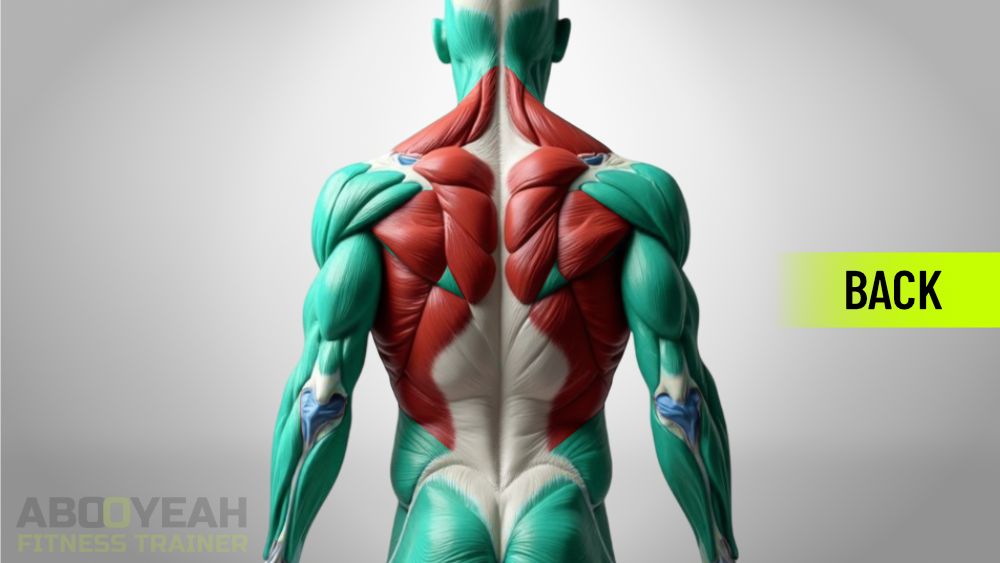
Function:
The back muscles facilitate pulling actions (e.g., pull-ups), shoulder blade retraction for posture, and spinal extension (e.g., standing upright). The lats drive arm extension and adduction, rhomboids retract the scapula, teres major and minor aid humeral rotation, and erector spinae stabilize and extend the spine. Weak back muscles, often from prolonged sitting, increase injury risk, per a 2018 Journal of Occupational Health study [5].
Best Exercises:
- Pull-ups/Chin-ups: Engage upper lats and teres major (bodyweight, overhand/underhand grip).
- Seated Cable Row: Targets the upper and middle back, including lats and traps
- Back Extensions: Strengthen spinal erectors for lower back stability.
- Lat Pulldown: Focuses on building a strong, defined back, including lats.
- Bent-Over Barbell Row: Targets the back for strength, including lats and traps.
- One-Arm Dumbbell Bench Row: Focuses on back strength and stability, targeting lats.
- Close-Grip Bent-Over Dumbbell Row: Builds a strong back, emphasizing lats.
- Lat Pulldowns Close Grip: Targets the upper back, including lats.
- Straight Arm Lat Pulldown: Focuses on back strength, targeting lats.
- Cable Close Grip High Row: Builds a strong upper back, including lats and traps..
- Bent-Over Dumbbell Row: Target middle/lower lats and rhomboids using dumbbells.
- Standing Dumbbell Shrug: Targets traps for powerful upper back development.
- Barbell Shrug: Builds powerful traps.
- Smith Machine Shrug: Focuses on traps for strength.
- Standing Shrugs with Band: Targets traps for strength.
- Incline Dumbbell Shrug: Builds traps for upper back strength.
- Smith Machine Behind-the-Back Shrug: Targets traps.
Training Tips: Maintain a neutral spine, vary grips to target different muscles, and prioritize pulling from the back, not arms. In Dubai, train in air-conditioned gyms like TrainSF or GymNation during summer. Avoid outdoor training to minimize possible heat stress, and hydrate frequently [4].
Dubai Insight: As a certified trainer with 14 years of experience, I guided my client Mohammed, a Dubai-based professional, to correct his posture using targeted trapezius and rhomboid exercises, like cable rows, at a top-tier DIFC gym. This approach counteracted the effects of long desk hours, boosting his confidence and comfort in daily life.
Key Moves: Pull-ups, Rows, Rack-Pulls, Face-Pulls, cable rows, back extensions.
Chest
“How much do you bench press, bro?” a classic gym saying that highlights the chest’s starring role in fitness culture. The chest primarily comprises the pectoralis major, a powerful muscle with upper and lower regions, essential for dynamic arm movements. While chest workouts are wildly popular and a staple in many routines, they aren’t always the most frequently trained muscle group, with legs or back often taking priority for balanced strength, per a 2020 Sports Medicine study [7]. As a Dubai-based trainer, I’ve seen clients obsess over the bench press, but true progress comes from hitting all chest regions for function and aesthetics. After all, as the saying goes, “Strong chest, strong quest!”
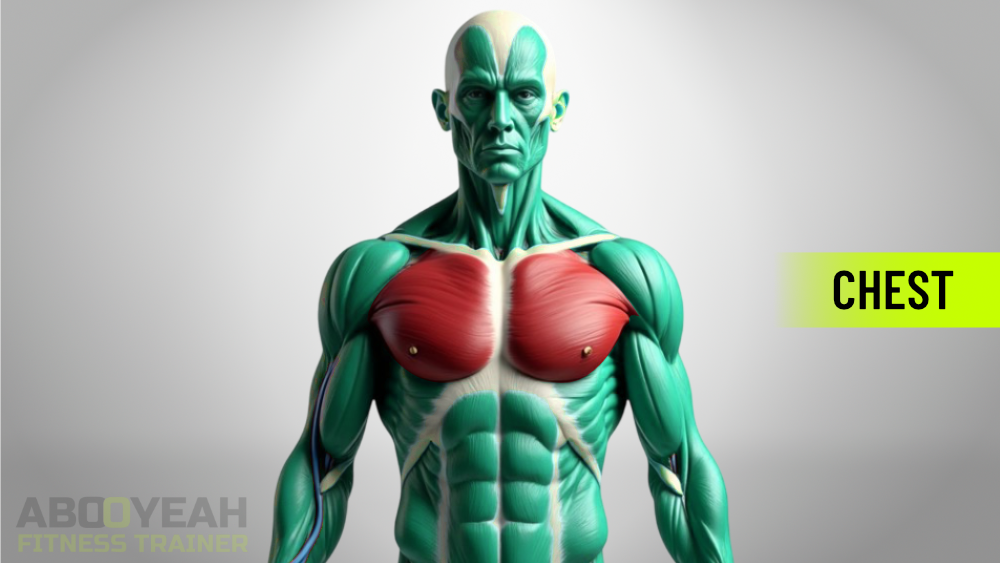
Structure:
- Pectoralis Major: The dominant chest muscle, connecting the sternum and clavicle to the humerus and front shoulder, driving major arm movements.
- Pectoralis Minor: A thin muscle beneath the pectoralis major, linking the rib cage to the scapula for shoulder blade stability.
- Serratus Anterior: Runs along the ribcage, attaching to the scapula to support forward arm motion.
- Subclavius: A small muscle from the first rib to the clavicle, aiding shoulder positioning.
Function:
The chest muscles power horizontal pushing (e.g., bench press), shoulder flexion, and internal arm rotation. The pectoralis major drives adduction and extension, while the minor and serratus stabilize the scapula, and the subclavius adjusts shoulder position. Overtraining the chest without balancing back exercises can lead to shoulder injuries, as noted in a 2020 Sports Medicine study [7].
Best Exercises:
- Barbell Incline Bench Press: Targets upper chest using barbells or dumbbells for a fuller physique.
- Push-ups: A versatile bodyweight exercise engaging chest, shoulders, and triceps, ideal for functional strength.
- Cable Flyes: Provide constant tension, perfect for 12-15 reps to isolate the chest post-compound lifts.
- Chest Dip: Focus on the chest with a slight forward lean, using bodyweight or added weight.
- Barbell Bench Press: Hits the middle chest, a staple for overall development.
- Reverse Grip Bench Press: Emphasizes the upper pectoralis for balanced growth.
- Dumbbell Flys on Bench: Builds a defined chest, targeting pectorals.
- Dumbbell Bench Press: Focuses on chest strength and stability.
- Dumbbell Incline Bench Press: Targets the upper chest for strength.
- Standing Low Cable Flys: Builds a defined upper chest.
- Standing Mid Cable Flys: Targets the chest for definition.
- Incline Dumbbell Flys: Builds a defined upper chest.
- Standing High Cable Flys: Targets the lower chest for definition.
- Barbell Decline Bench Press: Targets the lower chest.
- Close-Grip Push-Up: Engages chest as part of upper-body strength.
Training Tips: Incorporate varied bench angles (flat, incline, decline) to target all chest regions, retract shoulder blades for safety, and control the lowering phase to maximize muscle engagement. In Dubai’s intense summer heat, train in air-conditioned gyms like Gold’s Gym in Downtown or Bur Dubai to maintain focus and avoid heat stress. Hydrate with 8-10 ounces of water every 20 minutes [4].
Dubai Insight: With 14 years of certified experience as a personal trainer in Dubai, I helped my client Layla, a busy business consultant achieve her goal of performing 10 unassisted push-ups. Through a targeted progression plan at City Walk community gym, we improved her upper-body strength, enhanced daily functional performance, and boosted her confidence.
Key Moves: Bench press, push‑ups, cable flyes, dips.
Your Transformation Starts Now.
Shoulders
The shoulders are primarily composed of the deltoid muscles, which cover the upper arm and shoulder joint, a notably fragile area. These muscles consist of three distinct segments: anterior (front), lateral (side), and posterior (rear), each originating from different parts of the shoulder girdle but uniting at a single tendon on the humerus.
Strong shoulders enhance power, create a V-shape for men or curvy look for women, and support upper body movements, as noted in a 2017 Journal of Strength and Conditioning Research study [8]. As the gym saying goes, “Broad shoulders carry the load!” a nod to their role in both aesthetics and function.
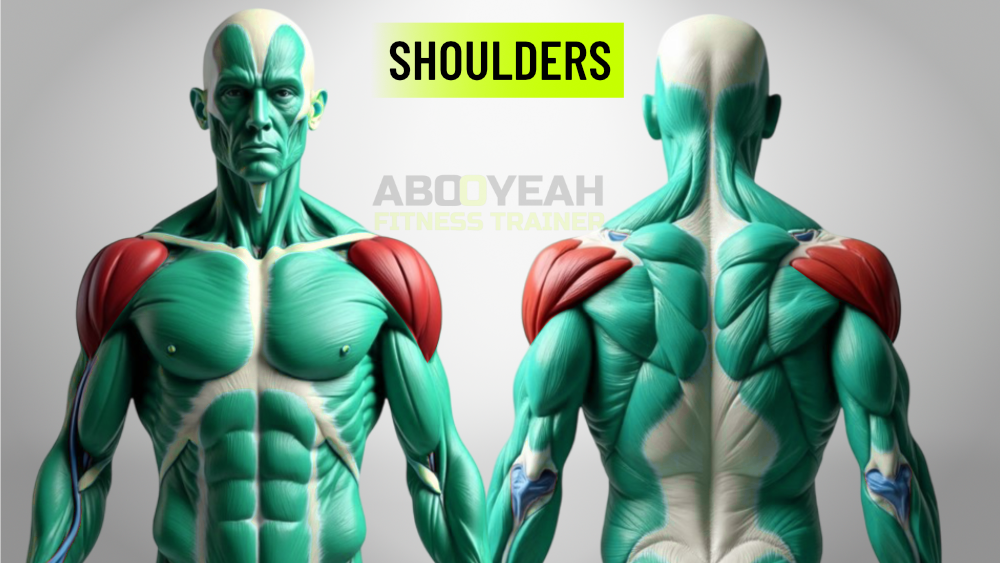
Structure:
- Anterior Deltoid: Originates at the clavicle and upper chest, connecting to the humerus alongside other deltoid heads.
- Lateral Deltoid: Extends from the acromion of the scapula to the humerus, aiding in arm abduction.
- Posterior Deltoid: Links the scapula’s spine to the humerus, supporting rearward arm movement.
- Rotator Cuff: Includes supraspinatus, infraspinatus, subscapularis, and teres minor, connecting the scapula to the humerus for rotational stability.
Function
Each deltoid segment contributes to arm elevation and rotation, with the anterior deltoid assisting in pressing motions and internal rotation, the lateral deltoid driving arm abduction and overhead presses, and the posterior deltoid aiding rearward arm movement with the latissimus dorsi. The rotator cuff ensures joint stability. Overtraining shoulders without proper form risks injury, per a 2020 Sports Medicine study [7].
Best Exercises
- Standing Barbell Military Press: Barbell or kettlebell, engaging all deltoid heads, a classic strength builder.
- Dumbbell Lateral Raise: Isolate lateral delts for width, using slow negatives (2-3 seconds).
- Standing Barbell Front Raise: Target anterior delts, lifting weights forward with control.
- Dumbbell Rear Delt Raise: Bend over, lift backward to strengthen posterior delts for depth.
- Upright Row: Focus on lateral deltoids, using a barbell or dumbbells for variety.
- Smith Machine Shoulder Press: Builds strong shoulders, targeting deltoids.
- Seated Dumbbell Military Press: Focuses on shoulder strength.
- Smith Machine Upright Row: Targets shoulders and traps.
- Dumbbell Shoulder Press: Builds strong shoulders.
- Standing Barbell Upright Row: Targets shoulders and traps.
- Standing Dumbbell Front Raise: Targets front delts.
- Seated Barbell Military Press: Focuses on shoulder strength.
Training Tips: Avoid locking elbows, start with light weights to perfect form, and balance all deltoid heads for comprehensive development. If overhead presses cause pain, switch to lateral raises to protect the shoulder joint. As the saying goes, “Raise the bar, not the pain!”
Dubai Insight: With a background in Sports Science and 14 years as a certified trainer in Dubai, I helped my client Omar a CrossFit enthusiast overcome recurring shoulder discomfort by addressing rear deltoid neglect. By incorporating targeted rear delt raises, we improved his scapular stability and significantly enhanced his overhead performance.
Key Moves: Overhead press, lateral/front/rear raises, upright rows.
Quadriceps
The quadriceps, a group of four muscles on the front of the thigh, are essential for leg strength and movement, often celebrated in gym culture with the saying, “Never skip leg day!” These include the rectus femoris, vastus lateralis, vastus medialis, and vastus intermedius, each originating from distinct points on the hip or femur but uniting at a shared tendon to extend the knee, as in kicking motions. Quad training boosts testosterone, enhancing overall fitness, per a 2018 Frontiers in Physiology study [9]. As a Dubai-based trainer, I’ve seen clients transform their athletic performance by prioritizing quads, ensuring both power and balance.
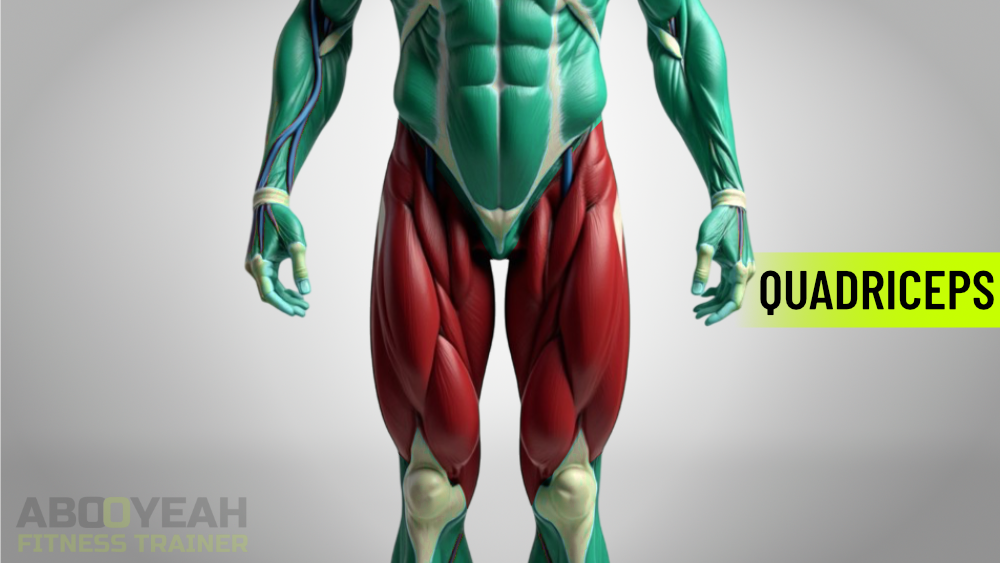
Structure:
- Rectus Femoris: Begins at the ilium (hip bone) and attaches to the tibia via the patellar tendon.
- Vastus Lateralis: The outermost quad, linking the femur to the tibia.
- Vastus Intermedius: Positioned between the lateralis and medialis, connecting femur to tibia.
- Vastus Medialis: The innermost quad, also joining the femur to the tibia.
Function:
The quads extend the knee (e.g., kicking) and, via the rectus femoris, assist in hip flexion (e.g., raising the knee). All four muscles collaborate to straighten the knee, but specific exercises can emphasize different regions. Quad training is vital for men and women to avoid imbalances and boost performance, as imbalances can limit overall fitness gains [9].
Best Exercises:
- Barbell Back Squat: Engage quads, glutes, and hamstrings, a fundamental move for lower body strength.
- Leg Press: Heavy, controlled emphasis on the vastus medialis.
- Bulgarian Split Squats: Unilateral, targeting quads and glutes for balance and stability.
- Goblet Squats: Beginner-friendly, holding a dumbbell at chest for form-focused quad work.
- Leg Extensions: Isolate the rectus femoris, with toes inward for vastus lateralis or outward for vastus medialis.
- Hack Squats: Emphasize outer quads, ideal for machine-based training.
- Machine Leg Press: Builds strong legs, targeting quads.
- Smith Machine Squat: Targets quads for strength.
- Seated Leg Extension: Sculpts strong quadriceps.
- Smith Machine Front Squat: Builds strong quads and core.
- Front Dumbbell Lunge: Builds quads, glutes, and hamstrings.
- Dumbbell Front Squat: Targets quads for leg strength.
- Barbell Front Squat: Builds strong quads and core.
- Dumbbell Squat: Engages quads and glutes.
- Single Leg Dumbbell Squat: Targets quads for unilateral strength.
Training Tips: Ensure knees track over toes, vary stances to target specific quad regions (e.g., toes out for vastus medialis), and prioritize form to prevent injury. In Dubai’s intense summer heat (41°C average [2]), use indoor leg press or hack squat machines at gyms like Fitness First to stay cool and focused. Hydrate with 8-10 ounces of water every 20 minutes to prevent cramps [4]. As the saying goes, “Strong quads, strong foundation!”
Dubai Insight: With a background in sports science and 14 years as a certified trainer in Dubai, I’ve seen how many clients initially avoid leg/quads workouts. Often due to how taxing they are and the dreaded delayed onset muscle soreness (DOMS). However, because the legs house the largest muscle groups in the body, training them offers unmatched benefits. I guided Nourdin, training at Binous gym, to master goblet squats. The results? A boost in confidence, daily mobility, and long-term strength gains. Scientifically, consistent lower-body training is linked to increased testosterone, elevated basal metabolic rate (BMR), and higher levels of natural growth hormone (HGH), making leg day a non-negotiable in any serious fitness plan.
Key Moves: Back squats, leg press, Bulgarian split squats, goblet squats, leg extensions, hack squats.
Ready to Build Stronger, More Powerful Legs?
Hamstrings
The hamstrings, located on the posterior thigh, consist of three muscles: biceps femoris, semitendinosus, and semimembranosus, key components of the posterior chain. As the gym saying goes, “Don’t skip the hams, build the power!” These muscles drive knee flexion and hip extension, critical for movements like bending the knee or extending the leg backward. Imbalances, particularly in females (2-8x higher knee injury risk than males), can compromise joint health, per a 2019 American Journal of Sports Medicine study [10]. In Dubai’s fitness scene, where functional training thrives, targeting hamstrings ensures athletic prowess and injury prevention.
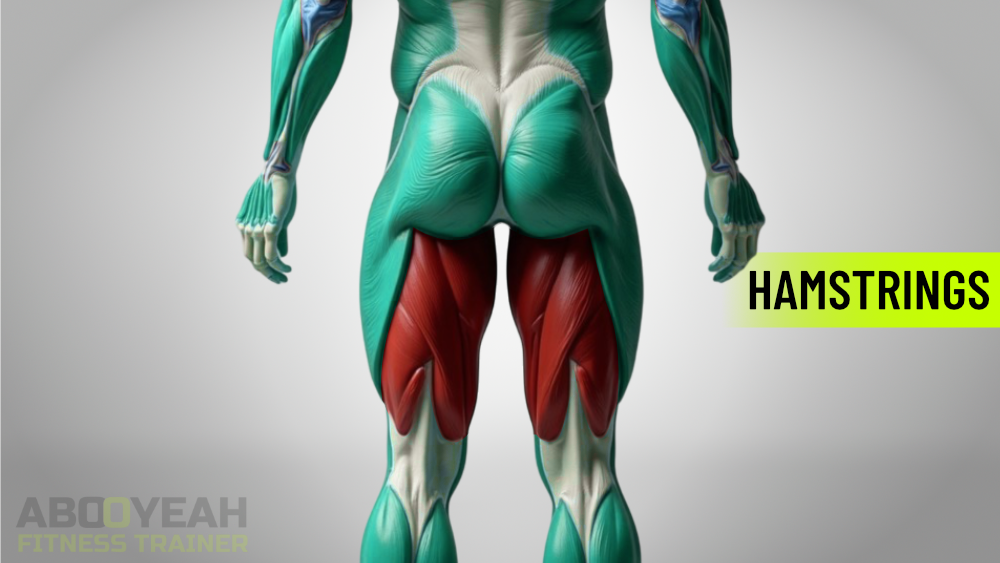
Structure
- Biceps Femoris: Originates at the ischium (pelvic sitting bone) and attaches to the fibula, a lower leg bone.
- Semitendinosus: Connects the ischium to the tibia, another lower leg bone.
- Semimembranosus: Also links the ischium to the tibia, supporting similar functions.
Function
The hamstrings flex the knee (e.g., bending during walking) and extend the hip (e.g., during sprints), with the biceps femoris also rotating the lower leg outward, while the semitendinosus and semimembranosus aid inward rotation. These actions are vital for athletic performance and stability, reducing knee injury risk when balanced with quad training [10].
Best Exercises:
- Hex Bar Deadlifts: Engage hamstrings and posterior chain, safer for beginners with a neutral grip.
- Romanian Deadlift (RDL): Focus on hamstrings with straighter legs, emphasizing hip extension.
- Seated Leg Curls: Isolate semitendinosus and semimembranosus, ideal for 10-15 reps.
- Glute-Ham Raises: Advanced, bodyweight or assisted, targeting all hamstrings.
- Lying Leg Curl: Focus on biceps femoris, complementing seated curls for complete hamstring work.
- Dumbbell Straight-Leg Deadlift: Targets hamstrings and glutes.
- Straight-Leg Deadlift: Focuses on hamstrings.
- Alternating Prone Leg Curl: Targets hamstrings unilaterally.
- Barbell Deadlift: Engages hamstrings as part of total-body strength.
- Front Dumbbell Lunge: Targets hamstrings, quads, and glutes.
Training Tips: Control the eccentric (lowering) phase to maximize muscle engagement, perform dynamic stretches pre-workout to loosen tight hamstrings, and maintain a straight back to prevent injury. In Dubai’s humid summer months (41°C average [2]), use indoor equipment at gyms like TribeFit to stay cool and avoid cramps, hydrating with 8-10 ounces of water every 20 minutes [4]. As the saying goes, “Strong hams, no slams—run and lift with ease!”
Dubai Insight: As a certified trainer with 14 years of experience, I helped my client Fatima, a female athlete, reduce knee pain by adding Romanian deadlifts at an Al Barsha gym, balancing her quads and boosting her sprint performance.
Key Moves: Hex bar deadlifts, Romanian deadlifts, seated/lying leg curls, glute-ham raises.
Calves
The calves, a powerhouse duo in the lower leg, consist of the gastrocnemius, with its distinctive heart-shaped appearance, and the soleus, nestled beneath it, both connecting to the heel via the Achilles tendon. As the gym saying goes, “Big calves, big swagger!” These muscles drive plantar flexion, crucial for movements like standing on tiptoes or pushing off during sprints, and their high endurance, due to slow-twitch fibers, suits high-volume training, per a 2020 Journal of Applied Physiology study [11]. In Dubai’s fitness scene, strong calves enhance both athletic performance and aesthetic appeal.
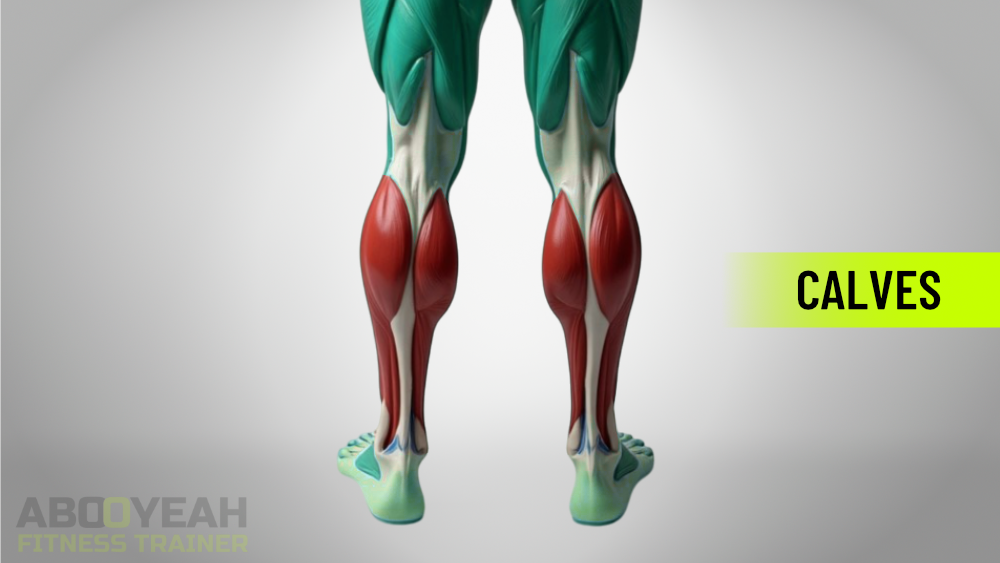
Structure
- Gastrocnemius: Originates at the femur’s base and connects to the heel via the Achilles tendon.
- Soleus: Extends from the tibia’s posterior surface to the heel, alongside the gastrocnemius.
Function
Both muscles power ankle flexion (e.g., toe-standing) and stabilize the lower leg during walking, running, or jumping. The gastrocnemius and soleus work together to support dynamic movements, with their endurance capacity making them ideal for high-rep training to boost strength and size [11].
Best Exercises:
- Standing Calf Raise: Straight legs, targeting the gastrocnemius with a 2-second hold at the top.
- Seated Calf Raise: Bent knees, focusing the soleus with a 3-second stretch at the bottom.
- Leg Press Calf Raises: Heavy loading, varying foot angles to hit both muscles comprehensively.
Training Tips: Use a full range of motion, aim for high reps (20-30) to leverage the calves’ endurance, and vary tempo for growth. A periodized approach, cycling rep ranges (e.g., 10-15, 20-30), maximizes development. As the saying goes, “Raise your calves, raise your game!”
Dubai Insight (My Personal Experience): With a background in Sports Science and 14 years of hands-on training experience, I’ve personally struggled with building my own calves—an issue many lifters relate to. Despite consistent training, my smaller calves were slow to respond.
Scientifically, this makes sense: calf muscles are predominantly made up of slow-twitch fibers, which are more resistant to growth. I applied high-volume seated calf raises with my client Nourdin in Binous Gym, helping him overcome similar genetic limitations. The results? Noticeable hypertrophy, improved symmetry, and a stronger stage presence.
Key Moves: Standing calf raises, seated calf raises, leg press calf raises.
Triceps
The triceps, located on the back of the upper arm, are composed of three muscle heads—lateral, medial, and long—comprising two-thirds of the arm’s mass and earning the gym nickname, “Horseshoe power!” These heads originate at distinct points but converge at a single tendon at the elbow, attaching to the ulna, driving elbow extension vital for pushing movements, per a 2019 Journal of Strength and Conditioning Research study [12]. As a Dubai-based trainer, I’ve seen clients like powerlifters and CrossFitters unlock massive strength gains by targeting all triceps heads. As the saying goes, “Strong tri’s, no goodbyes to gains!”
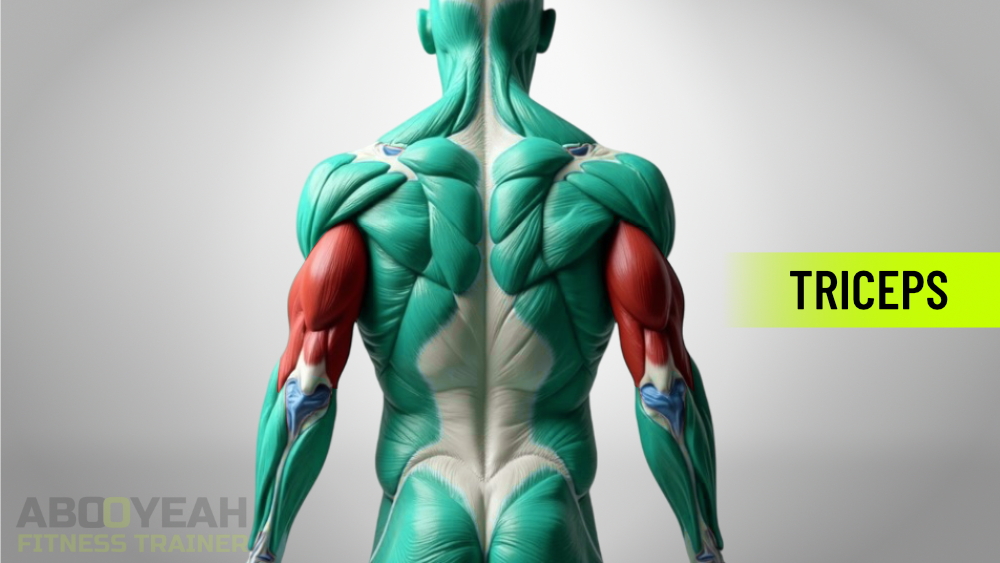
Structure:
- Triceps Brachii: Includes lateral and medial heads from the humerus and the long head from the scapula, all converging at the olecranon of the ulna (elbow).
- Anconeus: A small muscle beneath the triceps, running from the humerus to the olecranon and radius.
Function:
The triceps drive elbow extension (e.g., straightening the arm during a push) and assist in pressing motions, with the long head particularly active in overhead movements due to its scapular attachment [12]. The anconeus supports elbow extension and stabilization. Overhead exercises maximize long head stretch, while side-arm movements target lateral or medial heads, ensuring balanced strength to avoid shoulder strain.
Best Exercises:
- Close-Grip Bench Press: Compound move with heavy loading, hitting all triceps heads.
- Triceps Dips: Bodyweight exercise engaging all heads, ideal for functional strength.
- Overhead Tricep Extension: Focus on the long head with controlled 10-12 reps.
- Bar Tricep Extension: Isolate the lateral head with high reps, using a neutral or overhand grip.
- Lying Triceps Extensions: Target the long head with arms in front, using a barbell or EZ-bar.
- Standing Tricep Dumbbell Kickbacks: Isolate the lateral head with arms at the sides, emphasizing form.
- Cable Triceps Reverse Grip Extension: Builds strong triceps.
- Close-Grip Bench Press with Resistance Bands: Targets triceps for strength.
- Close-Grip Push-Up: Targets triceps for upper-body strength.
- Two-Arm Standing Dumbbell Extension: Targets triceps for strength.
- Rope Tricep Extension: Sculpts strong triceps.
- One-Arm Cable Tricep Extension: Targets triceps unilaterally.
- Seated Dumbbell Overhead Tricep Extension: Builds triceps strength.
- Smith Machine Close-Grip Bench Press: Targets triceps for strength.
- One-Arm Incline Tricep Extension: Builds triceps unilaterally.
- Resistance Band Kickback: Sculpts triceps.
Training Tips: Keep elbows tucked to isolate the triceps, avoid locking out to prevent joint stress, and vary exercises to target all heads. Use an underhand grip for pushdowns to hit the medial head. As the gym wisdom goes, “Extend the tri’s, reach for the skies!”
Dubai Insight: As a certified trainer with 14 years of experience, I helped my client Mo, a Men’s Physique Athlete, boost his bench press by adding dips at Binous gym, enhancing his triceps strength and increase his 1-Rep Max on Bench.
Key Moves: Close-grip bench press, dips, overhead extensions, cable pushdowns, lying extensions, dumbbell kickbacks.
Biceps
The biceps, located on the front of the upper arm, consist of the biceps brachii, featuring two heads—long (outer) and short (inner)—earning the gym nickname, “Guns for glory!” These heads originate at different scapular points, with the long head attaching further back, and merge into a single tendon at the radius, enabling elbow flexion, as in dumbbell curls. The brachialis, a key assisting muscle, enhances arm rounding, per a 2018 Sports Medicine study [13]. As a Dubai-based trainer, I’ve seen clients like Aisha transform their arm strength with targeted bicep work. As the saying goes, “Curl hard, shine bright!”
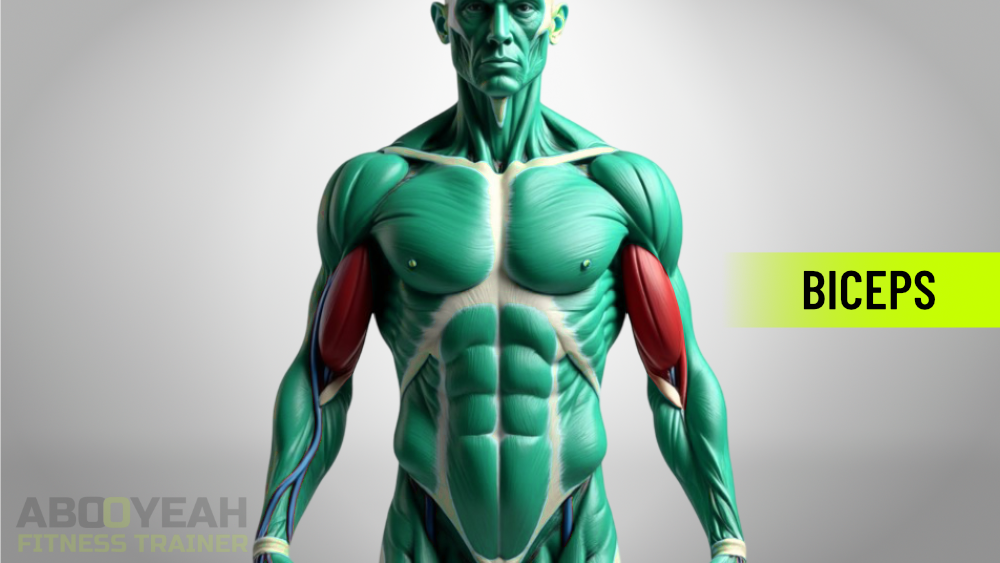
Structure:
- Biceps Brachii: The long head begins at the scapula’s supraglenoid tubercle, the short head at the coracoid process, converging at the radius.
- Brachialis: Extends from the humerus’s midpoint to the ulna.
- Brachioradialis: A forearm muscle, linking the lower humerus to the radius near the wrist.
Function
The biceps brachii flexes the elbow (e.g., curling), supinates the forearm (rotating it outward), and assists shoulder flexion with palms forward. The brachialis drives elbow flexion, especially in the initial phase, and is key with overhand grips, while the brachioradialis supports flexion in neutral or pronated grips, like hammer curls. This synergy, especially with brachialis focus, rounds the arms for aesthetics and function [13].
Best Exercises:
- Standing Barbell Curl: Classic move for full biceps engagement, building size and strength.
- Hammer Curls: Target the brachialis and brachioradialis with neutral-grip, palms facing in.
- Machine Preacher Curl: Isolate biceps by stabilizing arms, emphasizing peak contraction.
- DB Cross Body Hammer Curls: Targets biceps and forearms.
- One-Arm Standing Dumbbell Curl: Sculpts balanced biceps.
- Seated Alternating Bicep Curl: Targets biceps for strength.
- Standing Alternating Bicep Curl: Builds balanced biceps.
- One-Arm Preacher Curl: Targets biceps for balance.
- Bicep Curl with Band: Builds biceps using resistance bands.
- Incline Dumbbell Curl: Builds defined biceps.
- Standing Cable Bicep Curl: Targets biceps for strength.
- Incline One-Arm Bicep Curl: Builds defined biceps unilaterally.
- Standing Bicep Curl Dumbbell: Targets biceps for strength.
- Standing DB Reverse Curls: Targets biceps and forearms.
Training Tips: Control motion to avoid swinging, squeeze at the top for maximum contraction, and include brachialis and brachioradialis work for rounded arms. As the gym wisdom goes, “Flex the biceps, impress the crowd!”
Dubai Insight: As a certified trainer with 14 years of experience, I trained Aisha, a fitness newbie, to master chin-ups at a Jumeirah gym, doubling her arm strength and boosting her confidence for daily tasks.
Key Moves: Barbell curls, hammer curls, preacher curls, chin-ups.
Ready to Build Bigger Arms?
Abs
The abdominal muscles, or abs, dubbed the “core of confidence” in gym culture, comprise four key muscles: rectus abdominis (“six-pack”), external obliques, internal obliques, and transverse abdominis. These muscles flex and rotate the trunk while stabilizing the spine, but as a 2017 Journal of Obesity study notes, diet, not spot reduction, reveals abs [14]. In Dubai’s fitness hubs, a balanced ab routine targeting all regions is key to strength and aesthetics. As the saying goes, “Abs are made in the kitchen, sculpted in the gym!”
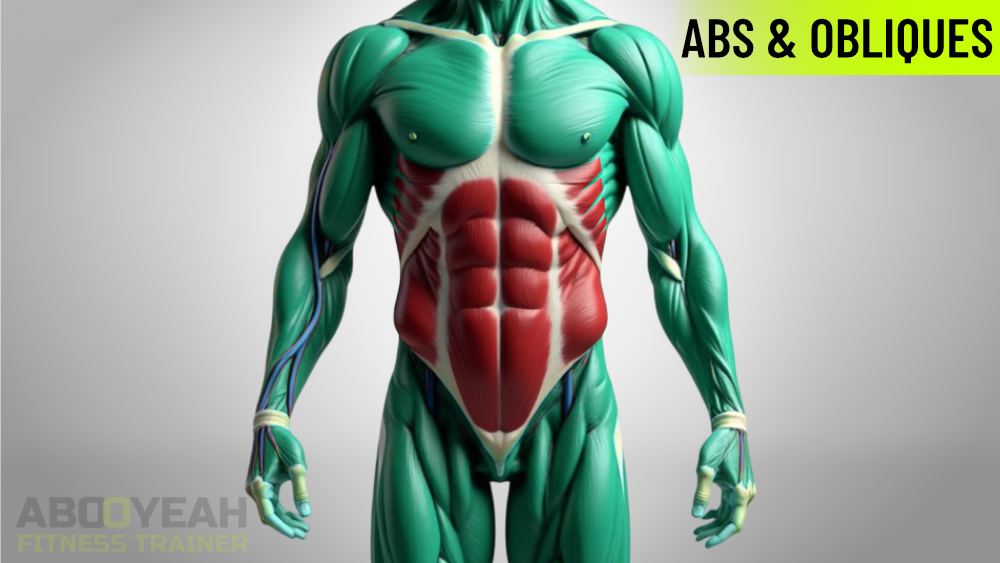
Structure
- Rectus Abdominis: The visible “six-pack” muscle, running from the pelvis to the ribs and sternum, separated by the linea alba connective tissue.
- Internal/External Obliques: Located on the abdomen’s sides, connecting lower ribs to the iliac crest (hip bone), with internal obliques beneath the external.
- Transverse Abdominis: A deep muscle linking the rib cage to the pelvis, lying beneath other abdominal muscles.
Function
The rectus abdominis flexes the spine, pulling the rib cage toward the pelvis, aiding posture. The obliques support spinal stabilization, abdominal compression, trunk rotation, and lateral flexion (side bending). The transverse abdominis stabilizes the spine and pelvis by pulling the navel inward, crucial for core strength. Diet and bracing exercises are essential for visible abs and functional stability [14].
Best Exercises
- Prone Iso Abs (Plank): Engage the transverse abdominis for core stability, holding for 30-60 seconds.
- Kneeling Cable Crunches: Target rectus abdominis with weighted spinal flexion for strength.
- Hanging Leg Raise: Focus on lower abs with controlled knee-to-chest lifts.
- Pallof Press: Anti-rotation move for obliques and transverse abdominis, stabilizing the core.
- Side Crunches: Target internal/external obliques with lateral spine flexion.
- Twisting Crunches: Engage obliques through spinal rotation for dynamic strength.
- Decline Crunches: Builds a strong core.
- Abdominal Twist Crunch: Sculpts a strong core with rotational movement.
- Cable Crunch on Ball: Targets the core using a cable.
- Bent Over Cable Crunch: Builds core strength.
- Leg Lifts on Ground: Targets the lower abs.
- V-Ups with No Equipment: Builds a strong core.
- Ab Crunches on Ball: Targets the core for strength.
- Russian Twist: Builds a strong, rotational core.
- Twisting Crunch with Band: Targets the core with rotational resistance.
Training Tips: Prioritize bracing (e.g., planks) over excessive flexion to build core stability, use weights for progressive overload, and pair with a balanced diet to reveal abs. Perform indoor core workouts at gyms like Crank Fitness during Dubai’s heatwaves (41°C average,[2]), hydrating with 8-10 ounces of water every 20 minutes [4]. As the gym wisdom goes, “Brace the core, conquer the floor!”
Dubai Insight: As a certified trainer with 14 years of experience, I helped my client Sameer achieve visible abs with planks and diet tweaks at a Sheikh Zayed Road gym, transforming his physique and confidence.
Key Moves: Push-up planks, cable crunches, hanging leg raises, Pallof press, side crunches, twisting crunches.
Forearm
The forearms, a powerhouse for grip strength, encompass a complex group of muscles in the lower arm, split into wrist flexors and extensors, earning the gym nickname, “Grip it and rip it!” Flexors, like the palmaris longus, drive wrist flexion, while extensors, such as the extensor carpi radialis, facilitate wrist extension, crucial for lifting and real-world tasks, per a 2021 Strength and Conditioning Journal study [15]. As a Dubai-based trainer, I’ve seen climbers and lifters transform their performance with forearm training. As the saying goes, “Strong forearms, no doors unopened!”
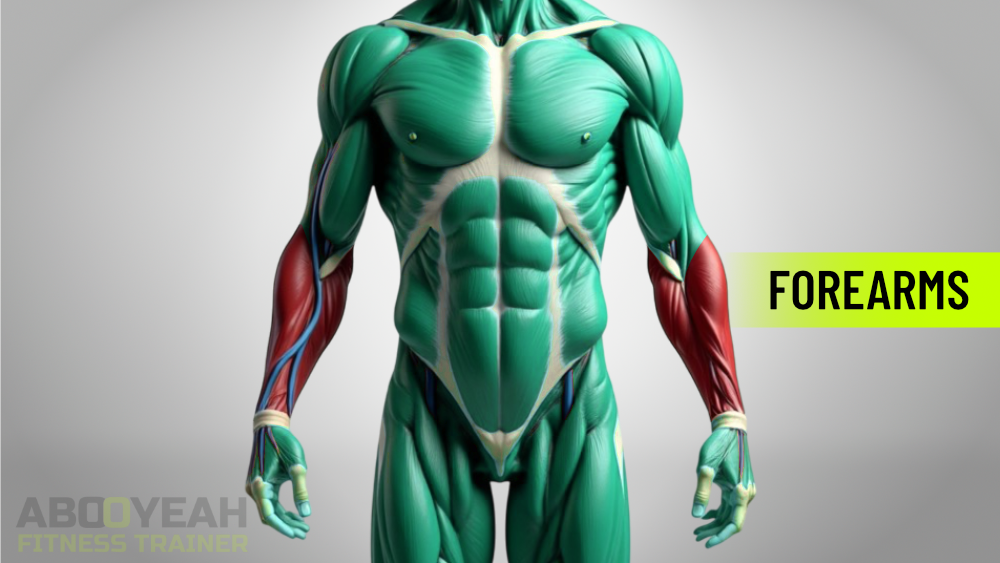
Structure:
- Flexors: Include muscles like the palmaris longus, flexor carpi radialis, flexor carpi ulnaris, and flexor digitorum superficialis, connecting the humerus, ulna, and radius to the palm side of the wrist, hand, and fingers.
- Extensors: Comprise muscles such as the extensor carpi radialis longus, brevis, extensor carpi ulnaris, and extensor digiti minimi, linking the ulna and radius to the back of the wrist, hand, and fingers.
Function
Flexors enable wrist and finger flexion (e.g., forming a fist) and forearm pronation (inward rotation), while extensors facilitate wrist and finger extension (e.g., opening the hand) and supination (outward rotation). Strong forearms enhance grip strength, reducing injury risk during back and biceps exercises and aiding tasks like carrying heavy loads [15].
Best Exercises
- Farmer’s Walks: Carry heavy kettlebells to build grip endurance, engaging both flexors and extensors.
- Wrist Curls: Target flexors with 15-20 reps, curling weights palm-up.
- Reverse Grip Barbell Wrist Curl: Focus on extensors with palms down, emphasizing control.
- Plate Pinches: Improve pinch grip by holding weight plates, enhancing functional strength.
- Seated Barbell Wrist Curl: Targets forearms for strength.
- DB Cross Body Hammer Curls: Targets forearms along with biceps.
- Standing DB Reverse Curls: Builds forearms and biceps.
Training Tips: Use thick bars or fat grips to increase challenge, stretch post-workout to maintain flexibility, and integrate grip work after biceps exercises, as forearms are heavily engaged in curls. If grip limits back or bicep performance, prioritize grip exercises like plate pinches first. As the gym wisdom goes, “Grip tight, lift right!”
Dubai Insight: As a certified trainer with 14 years of experience, I helped my client Ali, a climber, boost his grip strength with farmer’s walks at a Dubai Sports City gym, enhancing his climbing performance and endurance.
Key Moves: Farmer’s walks, wrist curls, reverse wrist curls, plate pinches.
Ready to Take Your Fitness to the Next Step?
Strength Training in Dubai During Summer
Dubai’s desert climate, with summer highs of 50.1°C (122°F) and 70% humidity [2], demands strategic training adjustments. The city’s vibrant fitness culture, spanning CrossFit boxes in Al Quoz, boutique studios in DIFC, and luxury gyms in Dubai Marina, offers ample indoor options, but outdoor enthusiasts must plan carefully. Here’s how to thrive:
- Timing: Train during cooler hours (6-8 AM or after 7 PM), avoiding peak heat (11 AM-3 PM), per NPRguidelines [6]. Parks like Zabeel or Safa are ideal for morning sessions.
- Hydration: Drink 8-10 ounces of water every 20 minutes, replacing each pound lost with 2-3 cups, per Academy of Nutrition and Dietetics [4]. Add electrolytes for intense sessions.
- Clothing: Wear light, breathable fabrics (e.g., Dri-FIT) in light colors to reduce UV exposure, per Skin Cancer Foundation [16].
- Acclimatization: Gradually increase outdoor workout duration over 2-4 weeks, starting in cooler months (e.g., November, 25°C average [2]).
- Indoor Options: Leverage Dubai’s world-class gyms (e.g., Binous Gym, TrainSF, Gold’s Gym) for air-conditioned comfort, especially for heavy lifts like squats or deadlifts.
- Safety: Watch for heat exhaustion (dizziness, nausea). Stop immediately if sweating ceases, signaling heat stroke, and seek medical help [6].
Conclusion
Mastering your body’s 11 major muscle groups unlocks a world of strength, balance, and resilience. By blending the exercises and tips above with Dubai-specific strategies, like early morning workouts, hydration, and leveraging the city’s top gyms, you can achieve your fitness goals safely and effectively. As a trainer who’s seen clients transform in Dubai’s dynamic fitness scene, I urge you to stay consistent, listen to your body, and embrace the journey.
Experience Elite 1-on-1 Personal Training in Dubai.
Abooyeah
Strength Training FAQ: How to Train All 11 Major Muscle Groups Effectively
How often should I train my glutes for optimal growth?
What are the best exercises for building a strong back?
How can I build a bigger chest?
What are the best shoulder exercises for mass?
How can I build stronger quads?
What are the best hamstring exercises?
How can I grow my calves?
What are the best tricep exercises for size?
How can I build bigger biceps?
What are the best ab exercises for a six-pack?
How can I strengthen my forearms?
References
- Journal of Strength and Conditioning Research, 2016: Muscle Balance and Injury Prevention
- Dubai Climate Data, 2023
- Medical News Today, 2019: Glutes and Lower Back Pain
- Academy of Nutrition and Dietetics: Hydration for Exercise
- Journal of Occupational Health, 2018: Sitting and Back Weakness
- NPR, 2021: Exercising in Hot Weather
- Sports Medicine, 2020: Chest Training and Shoulder Injuries
- Journal of Strength and Conditioning Research, 2017: Shoulder Training Benefits
- Frontiers in Physiology, 2018: Quad Training and Testosterone
- American Journal of Sports Medicine, 2019: Hamstring Imbalances
- Journal of Applied Physiology, 2020: Calf Training Volume
- Journal of Strength and Conditioning Research, 2019: Triceps Long Head
- Sports Medicine, 2018: Biceps and Brachialis
- Journal of Obesity, 2017: Spot Reduction Myths
- Strength and Conditioning Journal, 2021: Grip Strength Benefits
- Skin Cancer Foundation: UV-Protective Clothing
- Distefano, L. J., et al. (2009). J Orthop Sports Phys Ther, 39(7), 532–540

